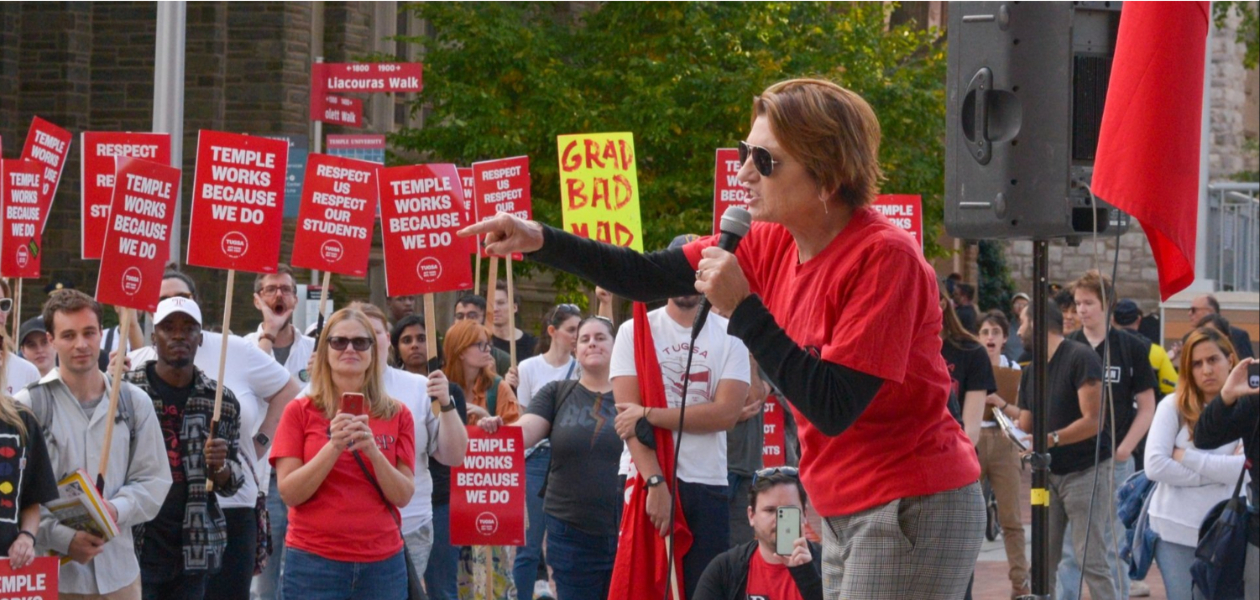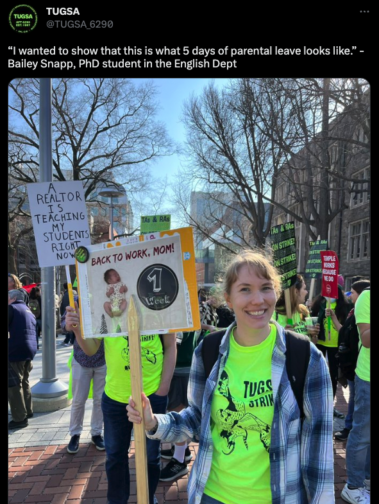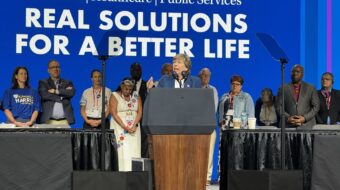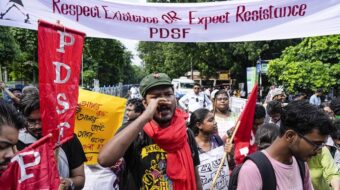
PHILADELPHIA—Last week, the Temple University Graduate Student Association (TUGSA) ended a historic 42-day strike by overwhelmingly ratifying a contract that included far more than the Temple administration ever insisted it would give.
The union faced unprecedented retaliation, persevering as members’ healthcare was manually shut off by their employer twice and tuition fees were charged to members totaling thousands of dollars.
As an institution that consistently markets itself as Philly’s “diversity university,” Temple is an alluring place for young people looking to find an education that caters to the poor and marginalized. That made its actions against striking student workers particularly appalling.
Keeping with the Temple University tradition of students fighting for social justice despite their administration, graduate student workers established the first and only graduate student union in the state of Pennsylvania here in 1997.
TUGSA has since been bargaining with the university in contract negotiations every four years, and its membership has grown steadily. It presently represents over 60% of graduate workers, which is no small feat when approximately 20% of your bargaining unit leaves at the end of each year.
A few of the notable wins TUGSA enshrined in the new contract include:
- The elimination of tiered wages.
- An immediate pay increase to $24,000 for employees with nine-month appointments (which, for full-year employees, becomes the $32,000 the union had as its goal wage). Additionally, graduate workers will receive a $500 return to work bonus and a $1,000/year raise for each of the four years this contract covers, an impressive precedent to set.
- Parental leave was increased from five days to three weeks.
- The creation of a workload review committee to guard against overwork and major changes to the grievance procedure should increase speed and improve outcomes.
- “Funeral leave” becoming “bereavement leave,” meaning workers no longer have to provide evidence that some part of leave was specifically a funeral. Leave has increased from three to four days, and it now covers the passing of grandparents and allows for an extra five-day extension for workers having to travel internationally.
- Dependent healthcare, which was previously not covered, is now partially subsidized, creating a foot in the door for future expansion and taking the costs down from 30% of the average salary per dependent to 13%.
- Guaranteed access to the list of bargaining unit members before the semester begins, as opposed to the previous amorphous deadline which frequently hindered union recruitment.

As the TUGSA strike winds down and the strike wave at other employers across the country ramps up, it is worth examining this fight to see what others can glean from this strike’s success. Having been on the ground for its entirety myself, I saw a number of practices and strategies TUGSA employed which others will hopefully replicate.
Fostering leadership
TUGSA’s Contract Negotiations Team included multiple former presidents of the organization. The current president is a second-year Ph.D. student, meaning he will be in a position to have both seen this round of contract negotiations and participate in the next one, as will his vice president. My strike captain was not the only first-year student in that position and even more first-years served as strike coordinators. This leadership structure, which engages and fosters talent early, set up TUGSA’s success from the beginning.
Strategic timing
Over two months passed between TUGSA’s strike authorization vote and the beginning of its strike for numerous reasons. As mentioned in my previous People’s World article on the strike, one of Temple University’s first strikebreaking measures was to threaten international workers’ visas. By avoiding a strike during the winter break, not only was TUGSA able to ensure international students were granted re-entry into the U.S. but also maximize picket visibility.
Additionally, unlike in most other industries, graduate workers are paid once on the final day of the month, rather than weekly or biweekly. By waiting until Jan. 31st specifically, TUGSA set up its strikers to have a month’s worth of pay in the bank, with the added benefit that Jan. 30th was Temple University’s final day to drop classes, a significant date for teaching contracts.
What “strategic timing” means for a workplace varies by industry and circumstance. TUGSA was able to adapt to the specifics of its conditions and this facilitated a more successful strike.
Radical transparency
Unions are supposed to be democratic institutions by definition, but TUGSA’s leadership was uniquely transparent with its members from the beginning. This paid dividends.
Leadership fought for open negotiations before the strike to ensure rank-and-file members were present to witness everything that happened and, when the administration demanded closed negotiations, diligently recounted everything they possibly could to rank-and-file afterward.

Leadership’s continued honesty with goals and expectations, sharing their perspectives and concerns, and managing the union as horizontally as possible built so much trust that when those inevitable times came that leadership was barred from sharing information with rank-and-file, we knew they were competent and respected their judgment. In return, information and rationales for decisions were shared after the fact if they could not be shared beforehand.
Solidarity between unions
From Unite Here showing up to reinvigorate the pickets with food and chants to the AFL-CIO hosting a rally for all locals despite the wind and rain, the solidarity that characterized this strike was palpable.
From the beginning, the American Federation of Teachers sent out fundraising emails to all other branches to raise money for the strike fund, and the recent Philadelphia Museum of Art Union, which had just come off strike, sent members to share information from their experiences. In fact, knowledge-sharing was one of the core facets of the inter-union relationship that benefitted TUGSA benefitted.
If you enjoy reading People’s World and the stories we bring you, support our work by donating or becoming a monthly sustainer today.
The union was in near-constant communication with other academic unions around the country which had been in similar positions, sharing ideas and strategies. TUGSA even directed its members to other unions’ demonstrations during the strike and, in the days since has made it clear that this will be the norm moving forward.
Temple University is home to nearly a dozen unions, as well as an organizing committee for undergraduate service workers, TUUWOC, that is presently fighting to unionize. TUUWOC put much of its own organizing on hold to stand with TUGSA. Meanwhile, TAUP, the union for professors at Temple, called for a vote of no confidence against the president, provost, and chairman of the board, which is presently scheduled for April 10th.
Utilizing political resources

It is not abnormal for unions to send delegates to lobby state senators and representatives. It is abnormal, however, to rent a charter bus and bring 50 neon-clad strikers to the state capitol all at once to canvass virtually every office there.
TUGSA was uniquely tactful in its use of its political resources. From enlisting electeds to draw the press while strikers signed up for food stamps to networking with state officials to work as go-betweens with the administration, TUGSA effectively walked a delicate line. It managed to avoid rejecting aid from potential allies while also never leaving the workers’ fate solely in politicians’ hands.
Innovative social media usage
Going viral on Twitter is not always a guarantee of success, but TUGSA rode its luck to a fair contract. By parlaying views into donations, endorsements, and alliances, TUGSA managed to spend 42 days on strike without ever getting lost in the news cycle.
The tone of TUGSA’s social media presence was informative yet personable. Meanwhile, because rank-and-file members were not policed in their online communications, the result was a parallel set of social media accounts under the name of “TUGSA Strike Crush.” While the official accounts kept their distance and provided information, the Strike Crush accounts not only engaged the talents of social media-minded members but also provided a space for informal communications and jokes.
While other types of leaders may have been concerned about this renegade account, TUGSA embraced it, taking it as a sign of member engagement and folding it into the union as an informal, autonomous social committee.
Amplifying members’ talents
TUGSA’s response to the Strike Crush phenomenon is a microcosm of the larger strategy TUGSA utilized: giving its members space to explore and utilize their talents for the cause.
One member who’s passionate about graphic design joined together with workers from the printmaking MFA program to produce T-shirts at rallies to fundraise. Before the strike, one union leader with programming talents used Python to generate mass emails for the union. (Mass emails would be part of the strategy throughout the strike.)
Speaking personally, I am a political scientist who at one point conducted preliminary research for a book on protest music; they handed me a megaphone and I taught the strikers my favorite union songs. On the musical front, our picket saw everything from electric guitars to accordions to an eventual entire brass section.
The union allowed space for and encouraged members to bring their passions to the picket line. By the end, professional dancers performed in the middle of our picket lines wearing TUGSA beaded bracelets and knitted TUGSA hats. Everyone had space to bring something to the table and, when given the opportunity, they did.
Adjusting to advice
Regarding everything from how frequently to take breaks to masking guidelines, TUGSA remained unafraid to adjust to good faith criticism. Leadership and members resisted the urge to “feed the trolls,” coming with critiques from without, while simultaneously listening to and adjusting to critiques from within.
The results are palpable in the contract ratification vote—344 to 8. This does not happen without members who feel comfortable voicing their concerns and leaders who take those concerns into account.
The parameters of a successful proposal were determined not by the negotiations team alone but by polling members and large group deliberation. Under those conditions, a successful vote was inevitable.
Collaborating with undergraduates
Neoliberal institutions like Temple view undergraduate students as “customers” of education. TUGSA was able to utilize this relationship the undergraduates had with the administration to apply pressure.

Learning loss caused by the hiring of unqualified scab teachers brought students to file an ongoing class action lawsuit. They risked their grades not to cross our picket line and instead held multiple walkout demonstrations, one of which included approximately 2,000 students.
On their own accord, the students formed a TUGSA solidarity committee which is continuing to operate even after the strike, rallying to ensure students who stood in solidarity with the union are not penalized for assignments they missed in scabbed classes.
Prioritizing joy and community
Burnout looms large over activist communities across the capitalist world, and unions are no different, but strike teams for TUGSA diligently guarded against fatigue by foregrounding camaraderie.
Unlike in other situations, where organizers must plan for the long-term while managing the short-term, strikes are ephemeral. They demand an “unsustainable” amount of effort because they are not meant to be sustained, and adjusting to temporary, high-level organizing can be a source of shock and overwhelm, even for seasoned organizers. TUGSA recognized this from the beginning and made sure that pickets, rather than adding stress, became the place strikers went for stress relief.
The strike fund was strategically used for communal lunches each day and healthcare costs to guarantee no one was left behind. Pickets were characterized by art, music, dancing, and banter between comrades. Strike teams became tight-knit families, and the union held more social events than before the strike, both formal and informal.
TUGSA never took itself too seriously, leaving space for jokes between chant leaders and witty slogans on friendship bracelets. The union understood that the best guarantee of longevity in an organizing space is the community it builds.
TUGSA balanced the serious task of striking and the solidarity that can come from just having fun together. By the end, we weren’t on the picket line every day just for the wages, the healthcare, or the benefits—we were there every day because the picket line was where all our best friends were.
It was the place to cry when the administration retaliated against us, with people who understood. It was the place to catch up with one another while walking in circles for hours. It was the place where we could vent or laugh or celebrate or scream—whatever we needed, we became for each other.
Through solidarity, as the saying goes, the union made us strong. That is why we won.
We hope you appreciated this article. Before you go, please support great working-class and pro-people journalism by donating to People’s World.
We are not neutral. Our mission is to be a voice for truth, democracy, the environment, and socialism. We believe in people before profits. So, we take sides. Yours!
We are part of the pro-democracy media contesting the vast right-wing media propaganda ecosystem brainwashing tens of millions and putting democracy at risk.
Our journalism is free of corporate influence and paywalls because we are totally reader supported. At People’s World, we believe news and information should be free and accessible to all.
But we need your help. It takes money—a lot of it—to produce and cover unique stories you see in our pages. Only you, our readers and supporters, make this possible. If you enjoy reading People’s World and the stories we bring you, support our work by donating or becoming a monthly sustainer today.












Comments